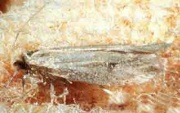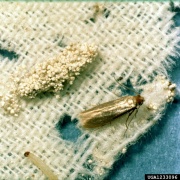Difference between revisions of "Casemaking clothes moth"
Jump to navigation
Jump to search
(username removed) |
|||
| (5 intermediate revisions by 3 users not shown) | |||
| Line 2: | Line 2: | ||
== Description == | == Description == | ||
| − | A clothes moth, ''Tinea pellionella'' Linnaeus and related species. Adult casemaking clothes moths are brown with 3 dark spots on each wing. The adult insects have a wing span of 7 to 9 millimeters. Eggs hatch in 4 to 7 days then the larva feed for 41-56 days. The larvae stage feeds on proteinaceous media, such as [ | + | A clothes moth, ''Tinea pellionella'' Linnaeus and related species. Adult casemaking clothes moths are brown with 3 dark spots on each wing. The adult insects have a wing span of 7 to 9 millimeters. Eggs hatch in 4 to 7 days then the larva feed for 41-56 days. The larvae stage feeds on proteinaceous media, such as [[wool|woolen]] fabrics, [[hair]], [[pelt|pelts]], [[hide|hides]], and [[feather|feathers]]. The 7-8 mm long larvae are white with a brown head. They encase themselves in a case spun out of the material the were feeding on. They pupate into moths in 9 to 20 days then just live long enough to mate and lay new eggs (4 to 7 days). |
[[File:Casemaking.clothes_moth_forestryimages.org.jpg|thumb|Casemaking clothes moth]] | [[File:Casemaking.clothes_moth_forestryimages.org.jpg|thumb|Casemaking clothes moth]] | ||
| Line 8: | Line 8: | ||
case-bearing clothes moth | case-bearing clothes moth | ||
| − | |||
| − | |||
| − | |||
| − | |||
== Additional Images == | == Additional Images == | ||
| Line 20: | Line 16: | ||
</gallery> | </gallery> | ||
| + | == Resources and Citations == | ||
| − | + | * MuseumPests.net: [http://www.museumpests.net/pdfholder/11image.pdf Casemaking Clothes Moth] | |
| − | * | + | * Lynda A. Zycherman, J.Richard Schrock, ''A Guide to Museum Pest Control'', FAIC and Association of Systematics Collections, Washington DC, 1988 |
[[Category:Materials database]] | [[Category:Materials database]] | ||
Latest revision as of 12:41, 3 September 2020
Description
A clothes moth, Tinea pellionella Linnaeus and related species. Adult casemaking clothes moths are brown with 3 dark spots on each wing. The adult insects have a wing span of 7 to 9 millimeters. Eggs hatch in 4 to 7 days then the larva feed for 41-56 days. The larvae stage feeds on proteinaceous media, such as woolen fabrics, Hair, pelts, hides, and feathers. The 7-8 mm long larvae are white with a brown head. They encase themselves in a case spun out of the material the were feeding on. They pupate into moths in 9 to 20 days then just live long enough to mate and lay new eggs (4 to 7 days).
Synonyms and Related Terms
case-bearing clothes moth
Additional Images
Resources and Citations
- MuseumPests.net: Casemaking Clothes Moth
- Lynda A. Zycherman, J.Richard Schrock, A Guide to Museum Pest Control, FAIC and Association of Systematics Collections, Washington DC, 1988



